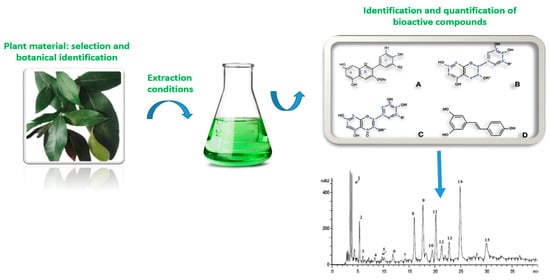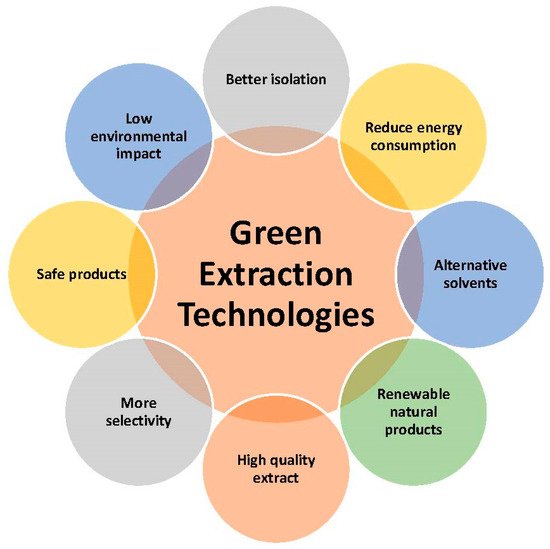1. Introduction
Usually, functional foods are considered as food product identical in all aspects to conventional foods except that it contains some biologically active compound (BAC) as an added ingredient [
1]. Even though designing a new food product is generally an expensive venture [
2], functional foods can be developed practically from various raw materials by means of the process of enrichment, fortification or other alteration of nutritive components [
3]. Recent trends in global food markets showed that consumers demand foods from plant materials that are deemed as “safe”, “fresh”, “natural”, and with “nutritional value” while produced and processed with sustainable methods [
4]. Such raw materials include minimally processed fresh fruits [
5,
6,
7,
8,
9,
10,
11,
12,
13,
14], vegetables [
15,
16], medicinal and aromatic plants [
17,
18,
19], and their wastes and by-products [
4,
20,
21,
22,
23]. Currently, functional foods commonly incorporate some plant extract(s) rich in BACs (
Figure 1) that are produced with conventional extraction that frequently has some negative thermal influences on extraction yield and quality [
24]. Hence, it is preferable to obtain extracts by some sustainable extractions, such as microwave-assisted extraction (MAE), ultrasound-assisted extraction (UAE), high-pressure assisted extraction (HPAE), high voltage electric discharges assisted extraction (HVED), pulsed electric fields assisted extraction (PEF), supercritical fluids extraction (SFE), among other methods [
17,
25,
26]. These techniques are aligned with the “green” concepts (
Figure 2) and able to provide raw materials on the industrial scale with optimal expenditure of energy and chemical solvents [
27,
28]. Engineered food products should have acceptable food structure, composition, and stability that is supportive of their traceability and authenticity [
29].
Figure 1. Bioactive compounds from plant extracts: from selection of plant materials to quantification of BACs.
Figure 2. Advantages of the use of green technologies to extract bioactive compounds from plant sources.
2. Health Benefits of Plant Materials
As earlier mentioned, health benefits in functional foods frequently come from BACs and depend on their extraction (natural) sources and the chemical structure. Plants have different mixtures of BACs that exert medicinal benefits; however, generally they have a single characteristic group of compounds that provide typical medicinal roles in the human body. For instance, antioxidative polyphenols from apple (
Malus domestica L.) are phenolic acids, e.g., chlorogenic and coumaroylquinic acids, and flavonoids, e.g., epicatechin, phloretin, and quercetin [
30]. The flesh of mandarin fruit (
Citrus reticulate Blanco) contains high nutritive content of antioxidants, (e.g., ascorbic acid, carotenoids, and phenolic compounds), in addition to sugars, organic acids, amino acids, pectin, minerals, and volatile organic compounds. Additionally, peel contains essential oils rich with limonene, β-myrcene, 3-carene, and α-pinene [
13]. The most of the health benefits associated with mandarin fruits come from antioxidative activity of its BACs. Next, the prickly pear fruit (
Opuntia spp.) contains high contents of polyphenols, betalains, betacyanins, ascorbic acid, amino acids, minerals, and other compounds [
31,
32,
33,
34,
35] that are associated with antioxidant, antiatherogenic, antiulcerogenic health benefits, as well as prevention of low-density lipoproteins peroxidation [
36,
37,
38]. Berry fruits such as bearberry (
Arctostaphylos sp.), blueberry (
Vaccinium sp.), blackberry (
Rubus sp.), blackcurrant (
Ribes nigrum), cranberry (
Vaccinium sp.), cloudberry (
Rubus chamaemorus), strawberry (
Fragaria ananassa), pomegranate (
Punica granatum), and grape berries (
Vitis sp.), and their extracts are rich in antioxidants [
18].
Mainly this is referred to the ascorbic acid and polyphenols (e.g., anthocyanins, phenolic acids, flavanols, flavonols, and tannins), with reported health benefits for cardiovascular diseases, cancer, rheumatoid arthritis, lung diseases, cataract, Parkinson’s, and Alzheimer’s disease [
14,
18,
39]. One of the important vegetable representatives are
Allium sp. (e.g., garlic, onion, leeks, and chives) that are known for their organosulfur compounds (OSC) even though they contain high quantities of flavonoids, steroidal saponins, and phytosterols [
40]. Their multiple health benefits include antimicrobial, antiviral, antidiabetic, anti-protozoal, antioxidant, antispasmodic, anticarcinogenic, antimutagenic, antiasthmatic, anti-amnesic, anti-inflammatory, hepatoprotective, neuroprotective, hypotensive, hypoglycemic, immunomodulatory, urease/xanthine oxidase inhibitors, and prebiotic properties [
41,
42,
43,
44,
45,
46]. Pumpkin (
Cucurbita sp.) is another vegetable that has considerable amounts of BACS in a form of terpenoids (especially carotenoids) responsible for the improvement of the immune system, lower the risk of cardiac and cancer diseases and enlargement of prostate gland [
15]. Some recognized sources of BACs are rosemary (
Rosmarinus officinalis L.) containing carnosic and rosmarinic acid, together with the carnosol that are BACs associated with antifungal, anti-diabetic, antiulcerogenic, anti-inflammatory, antithrombotic, and antidepressant health properties [
47,
48]. Medicinal and aromatic plants extracts are generally recognized as safe (GRAS), thus can be used as natural substitutes for chemical additives [
49]. For instance, sage (
Salvia officinalis L.) has strong potential as additive for (functional) food production due to its antioxidant properties [
50] and documented anti-inflammatory, anticancer, antimicrobial, and antiproliferative properties [
50,
51,
52]. In oregano (
Origanum vulgare), the main BACs are rosmarinic and caffeic acids with high amounts of flavonoids, namely hispidulin, and apigenin [
53]. Consumption of oregano was associated with antimicrobial and antioxidant activity [
54]. Thyme (
Thymus vulgaris L.) mostly contains thymol, carvacrol, geraniol, and
p-cymene [
55] and shows antibacterial [
56], respiratory [
57], and neuroprotective properties [
58]. Economic source of highly valued BACs is an industrial byproduct from winemaking, otherwise known as grape pomace, that has various polyphenolic antioxidants as flavonoids, phenolic acids, phenolic alcohols, stilbenes, and lignans [
59]. They showed medicinal effects in atherosclerosis, hypertension, neurodegeneration, myocardial, and other diseases [
59]. Similarly, citrus waste is commonly remained byproduct of citrus juice production that is rich with essential oils, limonoids, and polyphenols, e.g., flavonoids [
60]. Citrus peel is particularly rich in flavonoids, carotenoids, dietary fiber, sugars, polyphenols, essential oils, and ascorbic acid [
61]. BACs from citrus waste is mostly responsible for antioxidant activity while essential oils were antibacterial, antimycotic, antiviral, and antiprotozoal agents [
62].
Stevia rebaudiana Bertoni leaves have a large potential for production of non-caloric sweeteners due to steviol glycosides and other by-products [
63]. Indeed, stevia is also an excellent source of BACs such as polyphenols, chlorophylls, carotenoids, and ascorbic acid, while its extracts have antimicrobial, antioxidant [
64,
65], anti-hyperglycemic, anti-hypertensive, anti-inflammatory, anti-tumor, anti-diarrheal, diuretic, and immunomodulatory properties [
66]. Olive leaves (
Olea europaea L.) considered as both, waste from olive oil production and medicinal and aromatic plants have numerous polyphenols as oleuropeosides (oleuropein and verbascoside); flavonols (rutin); flavan-3-ols (catechin); flavones (luteolin-7-glucoside, apigenin-7-glucoside, diosmetin-7-glucoside, luteolin, and diosmetin). It also contains tyrosol, hydroxytyrosol, vanillin, vanillic acid, and caffeic acid [
67,
68,
69,
70]. Olive leaves extracts showed antitumor, antioxidant, hypolipidemic, antiviral, antimicrobial, cardiovascular, and anti-inflammatory health benefits [
71,
72,
73,
74,
75,
76]. Next step in obtaining high value-added compound is to identify the best extraction procedure and adequate processing relevant for food production.
Regardless of the method used to extract BACs, it is important to mention that the chemical composition should be assessed preferably using chromatographic methods (LC-MS, HPLC, and GC) and if the plant is not documented, toxicological studies using in vitro and in vivo assays should be carried out to attest its GRAS status. After that, possible functional effects in humans should be conducted, preferably using (pre)clinical trials, aiming to achieve a dose-dependent response.
3. Innovative Extractions and Processing of BACs
Any extraction procedure has a goal set to provide the highest amounts of target BAC in produced extract and with minimal contamination with other undesired compounds [
12,
77]. Hence, many extraction procedures are employed for such purpose. The solid–liquid conventional extraction is frequently used for extraction of polyphenols and other phytochemicals in order to facilitate the dissolution of the solutes, external transport by the release of solutes from a solid matrix to the solvent phase [
4]. The steam and hydrodistillation are most common commercially employed conventional extraction for extraction of BACs from medicinal and aromatic plants [
78]. The main extraction parameters are the type of extraction, plant material, particle size, solvent, acidity, temperature, time, and the addition of enzymes [
79,
80,
81]. A great deal of BACs is thermally unstable and can be either degraded or completely lost during the production of conventional extracts. While the conventional extraction is economic, it is still a time-consuming process with low selectivity and large consumption of solvents [
82,
83], hence not aligned with principles of green chemistry [
28,
84].
In processing, storage, and transport, encapsulation shelters BACs from air exposure, humidity, and light. Hence, preserves nutritive value, bioavailability, solubility, and functionality of BACs. From food engineering point of view, encapsulation masks off-flavors and odors, deconcentrates BACs, controls their release, and stimulates their handling in foods [
85].
This entry is adapted from the peer-reviewed paper 10.3390/foods7070106


